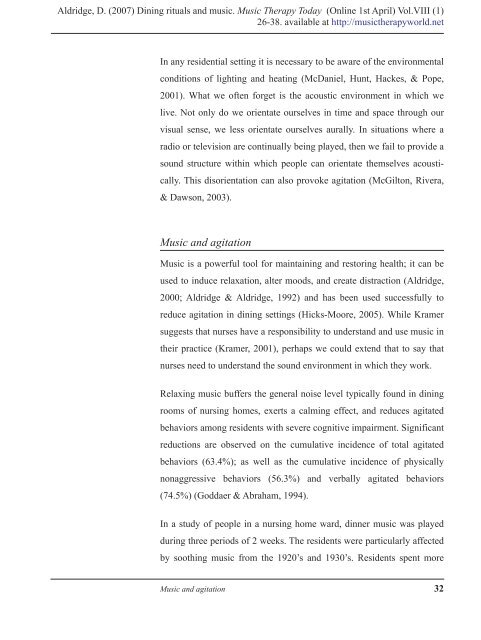Music Therapy Today - World Federation of Music Therapy
Music Therapy Today - World Federation of Music Therapy
Music Therapy Today - World Federation of Music Therapy
Create successful ePaper yourself
Turn your PDF publications into a flip-book with our unique Google optimized e-Paper software.
Aldridge, D. (2007) Dining rituals and music. <strong>Music</strong> <strong>Therapy</strong> <strong>Today</strong> (Online 1st April) Vol.VIII (1)<br />
26-38. available at http://musictherapyworld.net<br />
In any residential setting it is necessary to be aware <strong>of</strong> the environmental<br />
conditions <strong>of</strong> lighting and heating (McDaniel, Hunt, Hackes, & Pope,<br />
2001). What we <strong>of</strong>ten forget is the acoustic environment in which we<br />
live. Not only do we orientate ourselves in time and space through our<br />
visual sense, we less orientate ourselves aurally. In situations where a<br />
radio or television are continually being played, then we fail to provide a<br />
sound structure within which people can orientate themselves acousti-<br />
cally. This disorientation can also provoke agitation (McGilton, Rivera,<br />
& Dawson, 2003).<br />
<strong>Music</strong> and agitation<br />
<strong>Music</strong> is a powerful tool for maintaining and restoring health; it can be<br />
used to induce relaxation, alter moods, and create distraction (Aldridge,<br />
2000; Aldridge & Aldridge, 1992) and has been used successfully to<br />
reduce agitation in dining settings (Hicks-Moore, 2005). While Kramer<br />
suggests that nurses have a responsibility to understand and use music in<br />
their practice (Kramer, 2001), perhaps we could extend that to say that<br />
nurses need to understand the sound environment in which they work.<br />
Relaxing music buffers the general noise level typically found in dining<br />
rooms <strong>of</strong> nursing homes, exerts a calming effect, and reduces agitated<br />
behaviors among residents with severe cognitive impairment. Significant<br />
reductions are observed on the cumulative incidence <strong>of</strong> total agitated<br />
behaviors (63.4%); as well as the cumulative incidence <strong>of</strong> physically<br />
nonaggressive behaviors (56.3%) and verbally agitated behaviors<br />
(74.5%) (Goddaer & Abraham, 1994).<br />
In a study <strong>of</strong> people in a nursing home ward, dinner music was played<br />
during three periods <strong>of</strong> 2 weeks. The residents were particularly affected<br />
by soothing music from the 1920’s and 1930’s. Residents spent more<br />
<strong>Music</strong> and agitation 32

















